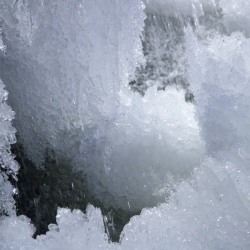
The problem with cryopreservation is that water expands when it freezes. If that water is in living tissue, it does all sorts of damage in the process. But an alliance of experts, ranging from surgeons and biochemists to mechanical engineers and food scientists, is attempting to overcome this inconvenient fact.
After years of labour, many of them think they are on the threshold of success, and that cryopreservation will soon become a valuable technology. Some human tissue is already cryopreserved. Frozen embryos have a couple of hundred cells, but are still tiny structures. Freezing full-sized organs has proved more problematic.
Dr Toner is using a sugar, trehalose, as a vitrifying “cryoprotectant”. The advantage of trehalose over glucose is that it is less reactive, and thus less likely to damage tissue in high concentrations. Its disadvantage is that it is not so readily absorbed into cells. Dr Toner has overcome that, though, by decorating it with molecular titbits called acetyl groups.
These act as chemical keys, granting entrance to otherwise inaccessible places. This seems to work. In June 2015 he and his colleagues showed that their acetylated trehalose could allow frozen rat cells to be revivified, just as they had hoped.
Revivification brings its own dangers, though. Warming cryopreserved tissue must be done rapidly, otherwise, paradoxically, it can cause ice to form where once there was only glass. This is because the non-aqueous part of the glass melts into a proper liquid before the water does, and thus separates out. The now-pure water then crystallises, with all the destructive consequences that follow.
This rapid warming must, though, be done uniformly, lest, in the words of John Bischof of the University of Minnesota, “the organ crack like an ice cube dropped into water”. Dr Bischof has hit on a novel solution to the problem. He and his colleagues propose adding tiny particles of magnetite, a form of iron oxide, to the cryoprotectant.
Put the organ in a rapidly fluctuating magnetic field and the magnetite will heat up fast. If the particles are scattered uniformly through the tissue, this heating should also be uniform. And recent experiments Dr Bischof has conducted on heart valves and arteries suggest it is.
Ido Braslavsky, of the Hebrew University in Jerusalem, is taking a different tack. Many species of cold-resistant fish, insects and plants employ proteins that actively inhibit the formation of ice crystals, even though they do not lower water’s freezing point. Dr Braslavsky has spent a long time studying such proteins, and he has built a special microscope to do so.
By attaching fluorescent tags to individual protein molecules, he can see exactly where they go and how they stymie the growth of ice crystals by attaching themselves to incipient crystals in ways that stop them extending themselves. (He applies this knowledge too, to the way ice formation influences the texture of ice-cream.)
Researchers have also devoted much effort to avoiding the deep freeze altogether, by perfusing organs with a cooled cocktail of preservatives, oxygen, antioxidants and the like. In a sense this is tantamount to keeping an organ on its own dedicated life-support system. Last year Korkut Uygun of Harvard Medical School, in collaboration with Dr Toner, demonstrated that a combination of cooling and perfusion could preserve a rat liver for four days.
All of these approaches, though, are quite intrusive. Kenneth Storey, of Carleton University in Canada, thinks a better tack is to try to understand and emulate the underlying molecular biology of cold-resistant creatures. He has studied in detail the changes to cell proteins and genes that go on in such organisms, including the actions of “micro-RNAs”, small molecules that can interrupt a cell’s gene-expression or protein-making machinery.
In December he published a catalogue of 53 micro-RNA changes that occur in wood frogs as they freeze. Hibernating mammals, insects and even nematode worms all seem to turn off their cells in similar ways to frogs. He therefore thinks there may be an overarching molecular signal which, if it could be found, would prepare organs for the freezer.
There are, then, many cryopreservationist ideas around, so many that some think a little co-ordination is in order. That is the purpose behind the Organ Preservation Alliance (OPA), an American charity which was set up in 2014. It has enjoyed some success. A year ago it held a hackathon, a kind of DIY-tinkering party to find novel solutions.
The winner, Peter Kilbride of University College, London, devised an ingenious vitrification method that uses tiny particles of silicon dioxide, sand, in essence, in lieu of the usual, potentially toxic cryoprotectants. It is a potentially transformative idea that has already been submitted for patent.
The OPA is also good at lobbying. Last year it persuaded America’s defence department, an organisation with an obvious interest in transplants, to seed seven cryopreservation-research teams with money. In January the department expanded the project with three new streams of money. The National Institutes of Health, the American government’s medical-research arm, is also paying for work on cryopreservation.
Venture capitalists, charities and individual philanthropists are queuing up to add to the rising pile of cash. The XPRIZE Foundation, for example, is considering offering an award to any team that can transplant into five animals organs that have been cryopreserved for a week.
The research-funding arm of the Thiel Foundation, started by Peter Thiel, who helped launch PayPal, has given a grant to Arigos Biomedical, a firm working on high-pressure vitrification. New firms abound: Tissue Testing Technologies is working on ways of warming organs uniformly; Sylvatica Biotech is perfecting recipes for cryoprotectants; X-therma is attempting to mimic cryoprotective proteins. The cryopreservation race is on, then. And the winning post is the organ bank.
